#drama: china
Explore tagged Tumblr posts
Text

just keep trying ruan nanzhu, it'll work out eventually 👍🏻
brought to you by this (no spoiler) novel excerpt:

#mine#drama#drama: china#the spirealm#kaleidoscope of death#quote twas not from this arc but i thought the vibe fit#my edit#the spirealm memes
152 notes
·
View notes
Text
OP: Kneeling up on the stairs, how did the director and screenwriter come up with it!
Cnetizens: This is the most sexual rizz and intensive movement design ever in guzhuang dramas and that's fucking genius

#china#video#douyin#fashion#xingzhangli性张力#lmao#funny#if fan fictions use this I'll fall for it#yeah old dramas are much wilder than today
844 notes
·
View notes
Note
If the coats with hoods aren’t historically accurate, what coats did Chinese people wear prior to the modern period?
Hi! Thanks for the question, and sorry for taking ages to reply!
By "coats with hoods", I assume you're referring to the doupeng/斗篷 (cloak/cape) commonly seen in modern hanfu and guzhuang (drama costumes), like the one below (x):
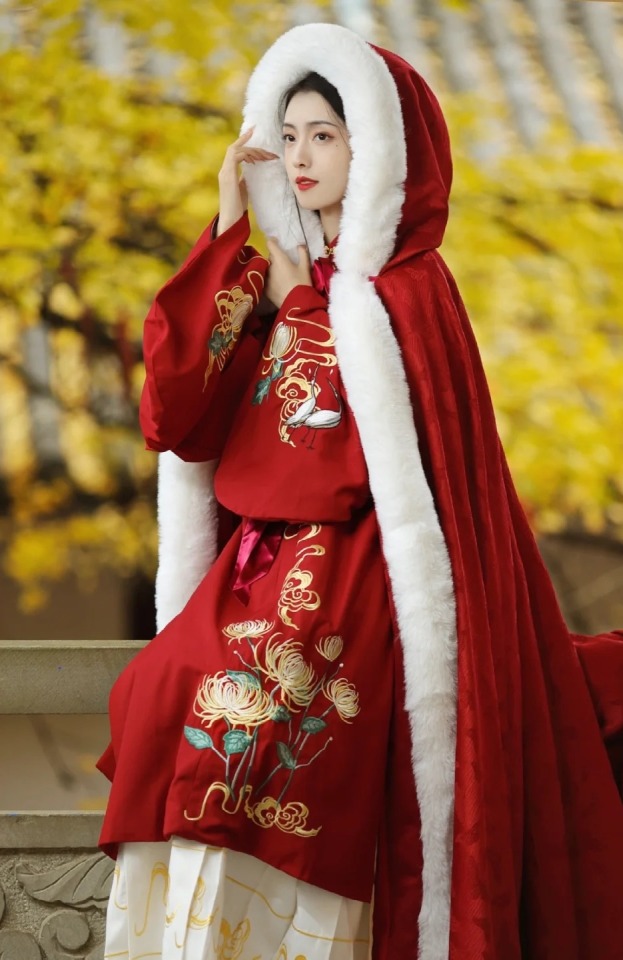
Chinese people did wear doupeng prior to the modern period, along with other kinds of coats. However, as I mentioned in my post here, historical Chinese doupeng did not have hoods attached to the cloak/cape. That is why many modern doupeng aren't considered historically accurate - because they have hoods attached. Below are examples of more historically accurate, hoodless doupeng (1/2):
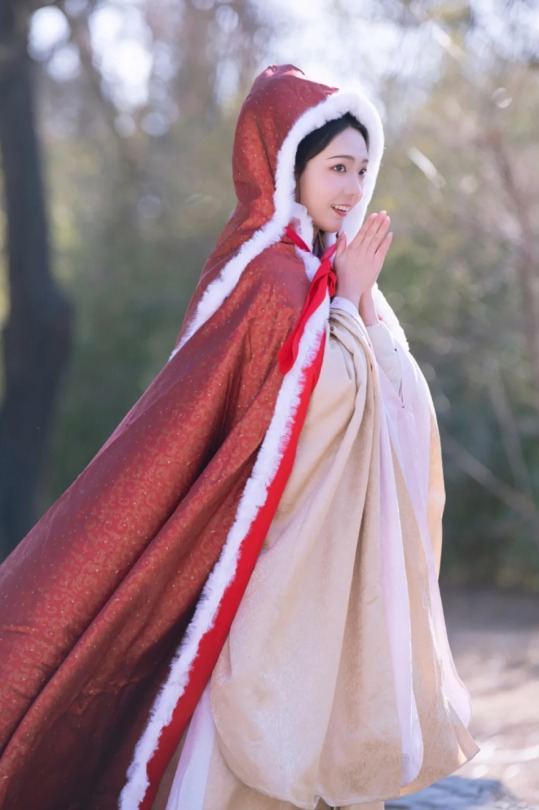
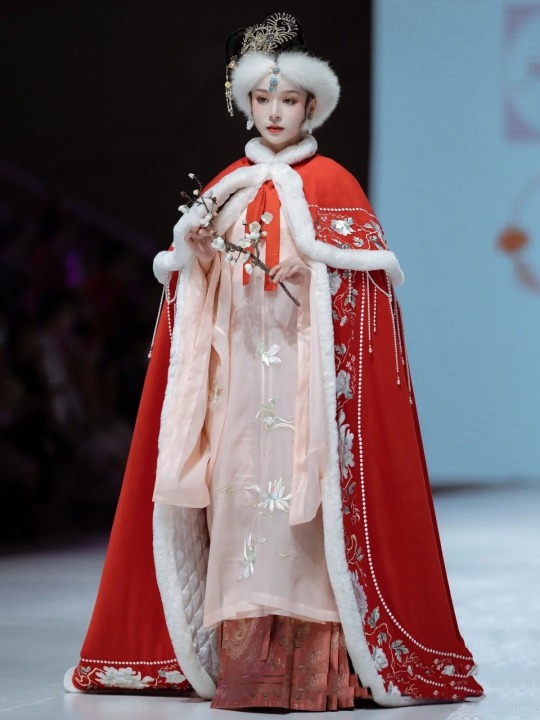
In the image on the above left, the model is wearing a separate, detached hood/hat called fengmao/风帽 (wind hat) which was historically worn to keep warm. Below - examples of fengmao (1/2):
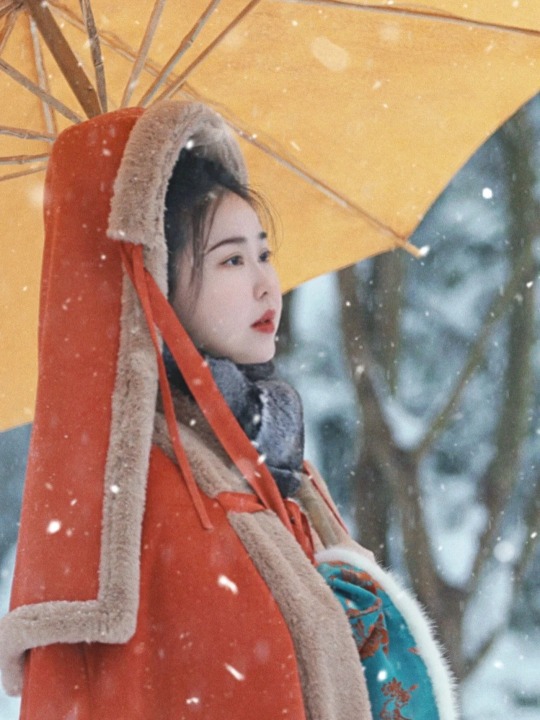

Historically, fengmao was often worn with doupeng when travelling during cold weather (x). Below - women wearing doupeng & fengmao in historical art (top row), and Chinese opera performers wearing doupeng & fengmao as part of their costumes (bottom row) (x):
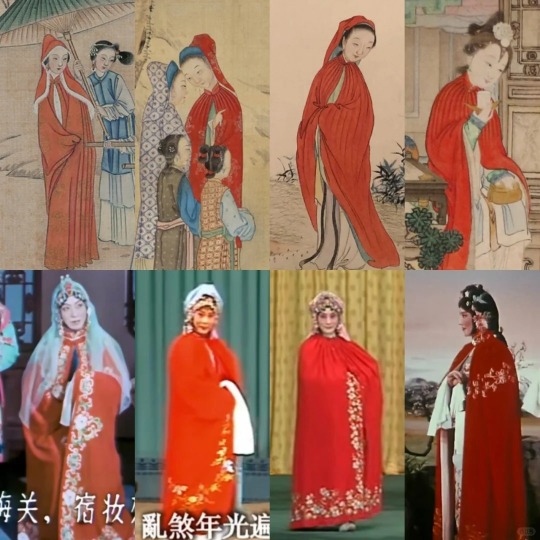
Oftentimes the doupeng & fengmao are matching, which can give the impression that they are attached - but if you look carefully, you can see that they are separate. Below - Chinese opera costume (x):
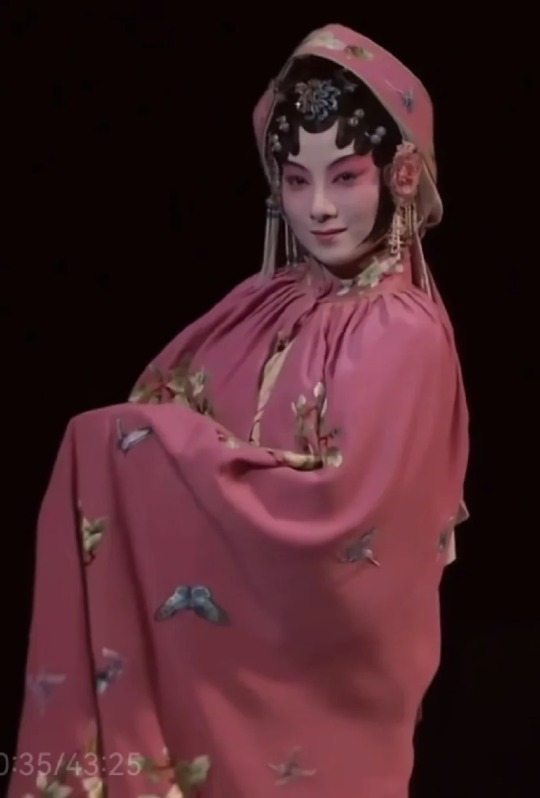
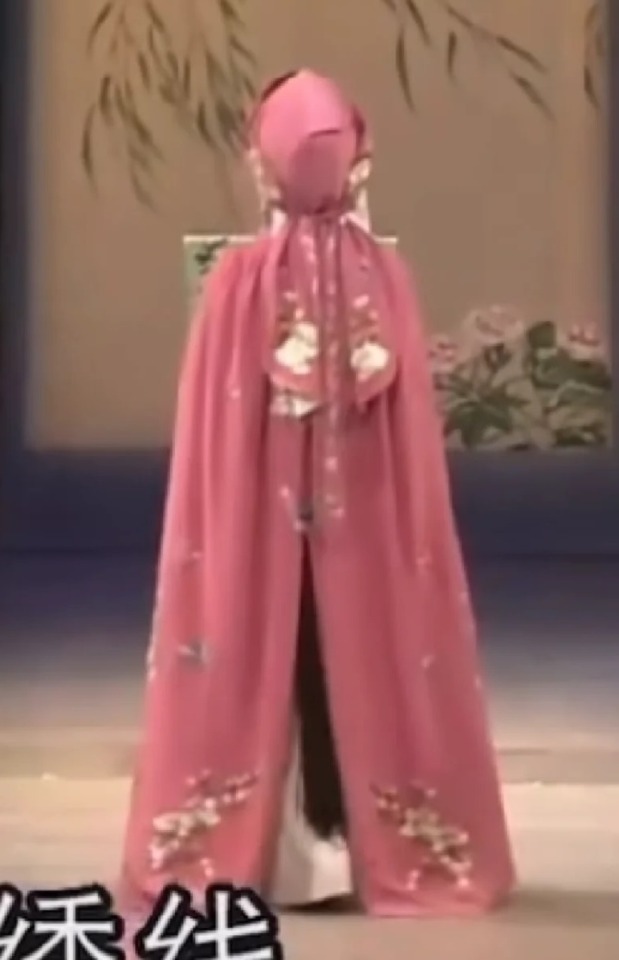
Below are historical photos of women wearing doupeng in 1920s Beijing - note how they are hoodless (1/2):
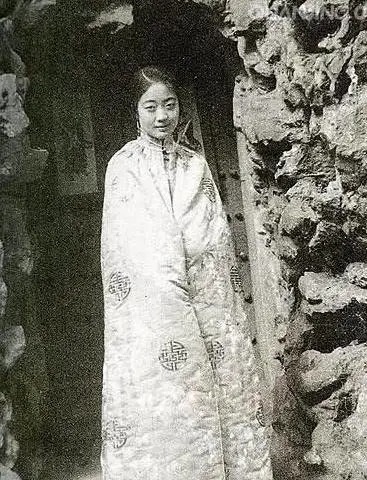
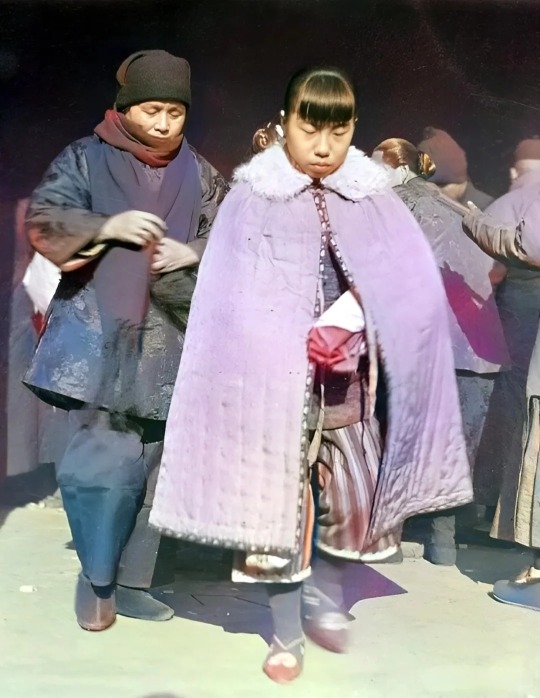
Hooded doupeng, in contrast, are more similar to historical western cloaks, such as the below American/European cloaks from the 18th century (1/2):


The hooded doupeng of modern hanfu are likely based on those seen in guzhuang dramas - another instance of drama costumes not being the most historically accurate (x):
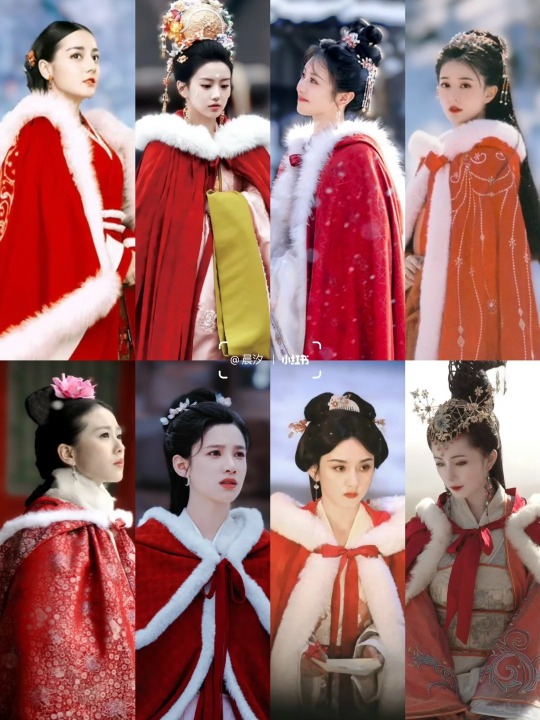
An example of a drama with a historically accurate depiction of doupeng & fengmao is the 1987 TV adaptation of Dream of the Red Chamber. As seen in the below images, the characters wear hoodless doupeng & occasionally matching fengmao as part of their winter wardrobe (1/2/3):

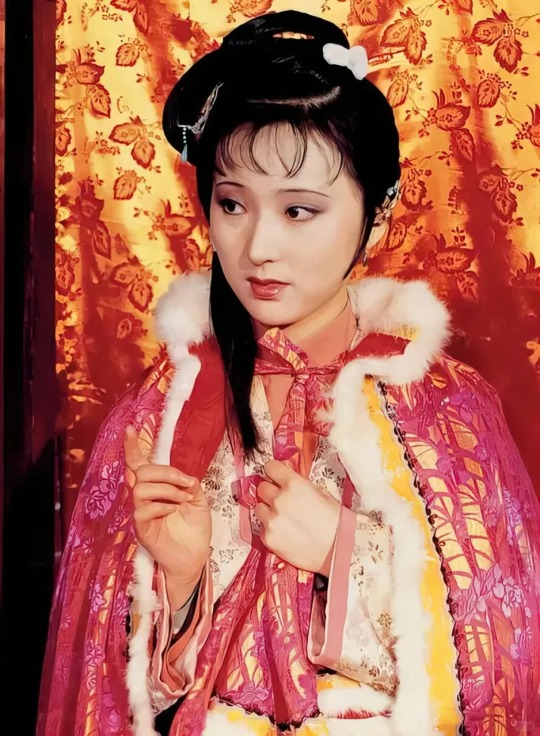

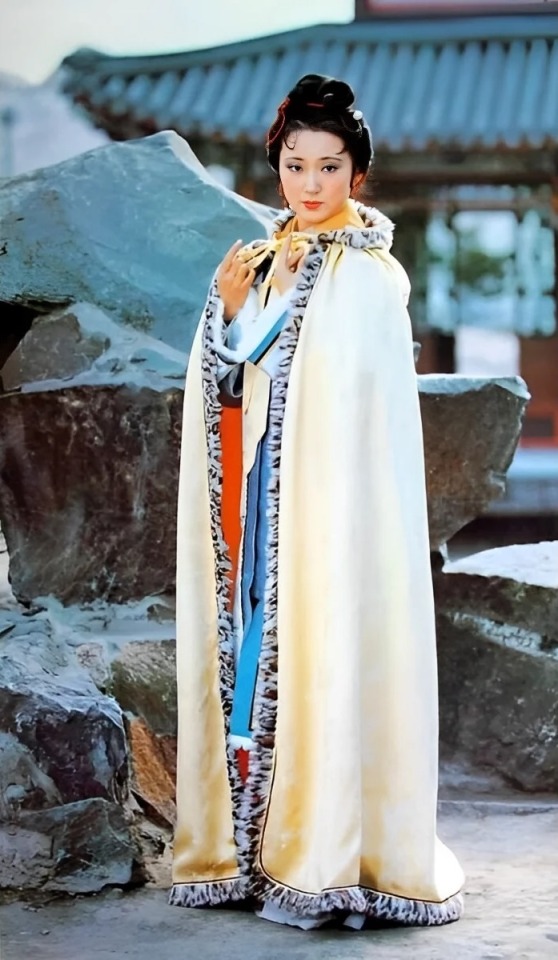
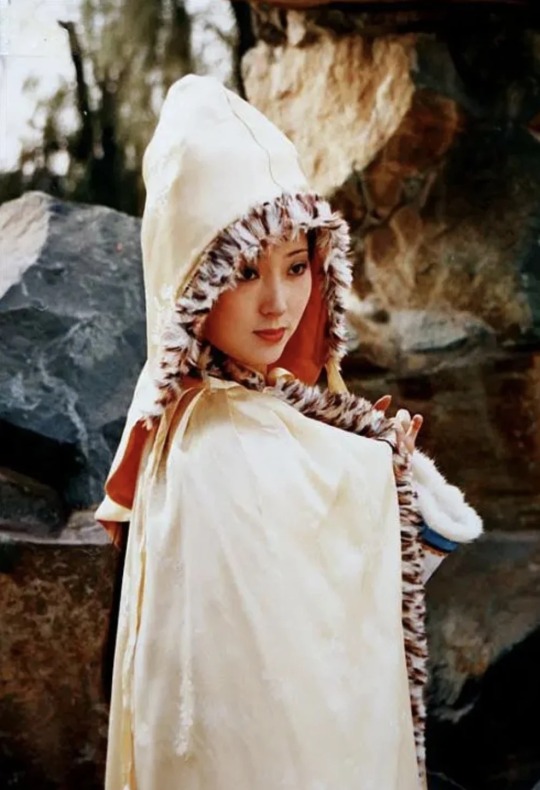
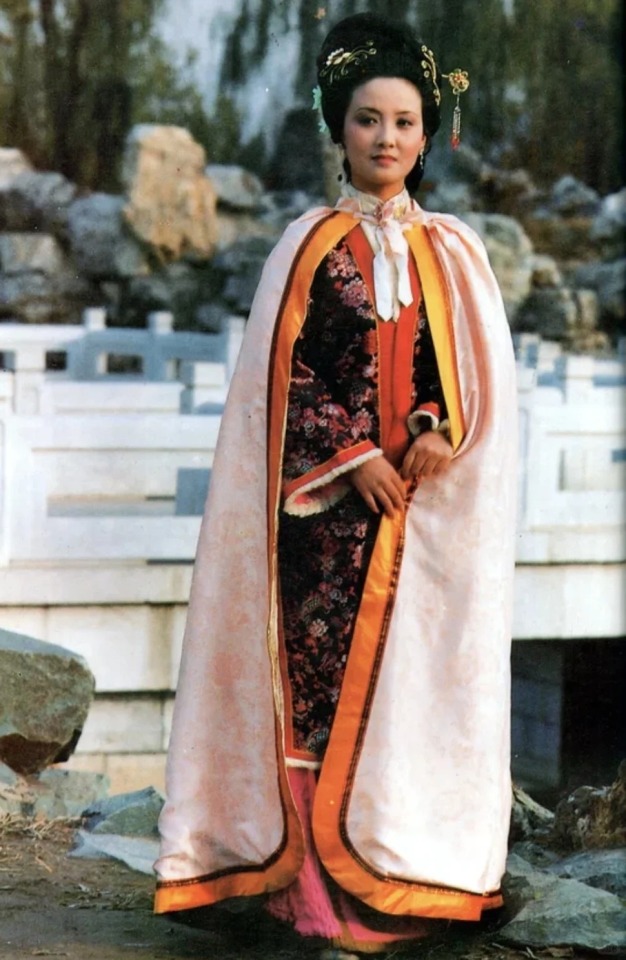

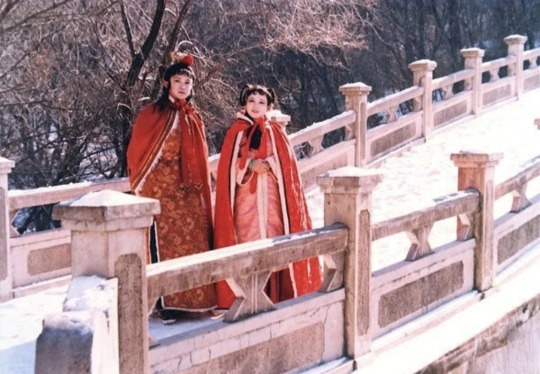
The 1994 TV adaptation of Romance of the Three Kingdoms also depicts historically accurate, hoodless doupeng & matching fengmao worn by men (x):
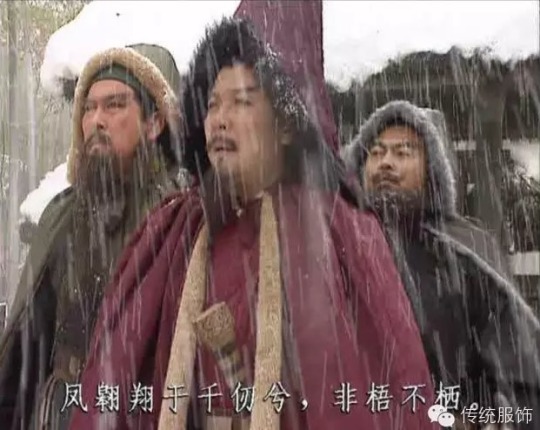
For more references, please check out my doupeng, fengmao, and winter wear tags.
Hope this helps!
#hanfu#doupeng#cloak#cape#fengmao#hats#winter wear#hanfu accessories#chinese opera#opera costume#xifu#drama costumes#dream of the red chamber#>500#china#history#reference#ask#reply#chinese clothing#chinese fashion#chinese culture
869 notes
·
View notes
Note
Hello there! I recently discovered your blog and it's really wonderful resource. I have a question and maybe you would be able to answer. From what I know the mourning garments are white, and I've seen some in movies or dramas. But I also saw many hanfu or hanfu-like costumes in dramas that predominately use white as a color for characters. So I am a bit confused, if what is considered mourning garment is much different (in style or in cut)? or the white clothes in dramas are just something modern and for aesthetics? I hope I'm making sense here.. Anyways, cheers and thanks in advance!
Unf, such amazing questions, I love it ❤️❤️
I'm going to answer this one very carefully because I don't want to get screamed at for "gatekeeping" 😆 Right off the bat I'm going to put a disclaimer:
Whatever show you enjoy, whichever actor/actress you like, you do you and have a good time. What I'm going to write is ONLY some trends in Chinese TV/movies over the past few decades, I'm not saying any show isn't "good", please don't hate me.
You're absolutely correct that historically, Chinese mourning clothes are white, but not just white, the material is also important. The actual term for mourning is "披麻戴孝" so if we break the words down:
披 (pi) = to wear on the body (like a cape) 麻 (ma) = hemp (fabric) 戴 (dai) = to wear, to hold, to have 孝 (xiao) = filial piety, show honour and love towards one's parents
So it's wearing white hemp and some sort of white fabric on the head to express one's respect for an elder. Mourning wear is only for those who are older than you (ex. parents, grandparents, older siblings, etc.), of a higher rank, or in some cases your superior (ex. solders in a battalion wearing mourning clothes when their captain passes).
I'll use some screenshots from the 1994 version of Romance of the Three Kingdoms as an example:

Pic 1-3: The emperor has passed away in this situation so everyone is in full mourning attire. His court (pic 1), his concubine (pic 2), his kid (pic 3). If you enlarge the image, you'll see the material they're wearing is quite rough-looking (best seen in pic 3, the other images' resolution aren't great).
Pic 4-6: In this funeral, the Wu Kingdom's Commander of the naval forces has passed away, so almost everyone is in full mourning because that's a very high rank.
Pic 5: You'll see the man on the right isn't in mourning because he's head of the Wu Kingdom, so his rank is higher than the Commander, therefore he doesn't wear mourning clothes.
Pic 6: This man is a visitor and frenemy of the Commander. He's coming from the Shu (Han) Kingdom and because they're not from the same Kingdom, there's no consideration of whose rank is higher or lower. Therefore, he's only worn a strip of white cloth over his hair out of respect (he technically doesn't even need to wear that). Now, obviously, even though he's not required to wear white hemp mourning clothes, it's not a good idea to show up in flashing pink or electric orange (very disrespectful), so he's gone with a soft, pale blue
Pic 7: In this image, a distant relative of the leader of the Shu (Han) Kingdom has passed away (at this point in the show the Kingdom hadn't been established, so he's only the head of a province). This particular relative is younger than everyone present, so; a) he's not ranked above them b) he's not older than them
Therefore, none of them are in full mourning, but they've tied a white cloth to their belt to express respect.
The man in blue, on the right, with the black hat is a visitor from the Wu Kingdom, so much like in Pic 6 he's coming to pay respect to someone not from his Kingdom (doesn't matter the rank) and not his senior) so he's not in mourning clothes (he doesn't even have a white cloth at his belt when he turns around).
So yes, white is traditionally a mourning colour but not all white coloured clothing is for mourning. If you're wearing a white silk robe with embroideries and designs, that's not considered mourning clothes.
Now, having said that, traditionally people still tried to stay away from full on, completely white outfits from head to toe. It's just not a lucky colour to wear. A jacket that's white, or a skirt that's white with a coloured border or some colourful accessories, not a big deal, but if you're going full white in everything...just, no, lol.
As for the Chinese period dramas/movies of today...that's a really deep well to dive through. I'll try to summarize it here and do more detailed posts later on.
TV dramas/movies are never 100% historically accurate, I'm sure everyone knows this, and we don't expect them to be. But for the Chinese entertainment industry it's been becoming less and less accurate in the last 20-25 yrs or so. In terms of clothing/make up/hair/set design/aesthetics in general, there's debate on why these changes have occurred (some say video games, some say foreign aesthetic influence, etc.) but the final result is a LOT of the costumes you see in period dramas today are very, very not historically accurate or even fitting to what is considered "traditional" Chinese aesthetics.
There's a LOT of these "Xianxia" shows going around, stories about immortals and "Gods", "xian/ 仙". I guess the character designers today feel that white somehow makes the characters feel more "immortal", more other-worldly, an imported aesthetic mainly from the West where "white" has been associated with "purity". There's actually growing push-back from the Chinese audience inside China against the character designs in recent years because people are beginning to feel like we're losing OUR aesthetic, these designs aren't what OUR Gods and immortals traditionally looked like. Here's a comparison:

On the left we have some shows and movies from the 80s and 90s, on the right we have more recent shows.
I'll be honest...some of the clothes on the right I barely consider "Hanfu". That's not to say they're not pretty, but the Hanfu influence in them is so small at some point I start thinking, "You're essentially wearing a large-sleeved dress...". In addition to the clothes, there's the hair, the makeup, even the buildings...they're...kind of East Asian styled but not really? I can't even say they're Chinese-styled because it's so generically East Asian some of these set designs.
Traditional Chinese aesthetics favoured bold colours, and the more power and wealth you had the larger the hair styles for women, with rich, beautiful accessories. Gardens and buildings are not minimalistic at all (that leans more Japanese style), rooms are not large and empty, even in large buildings each individual room are sectioned to be fairly small. There's a running joke on Bilibili (Chinese youtube) that the Heavens have gone bankrupt these days because the costumes, the hair, and buildings look so...bare xDD
Some audiences will say these shows are fiction anyway, not set in any particular time or country but...I mean, clearly they're not writing about a Western immortal or an African God, these stories are set in the frame of Chinese characters.
In any case, basically what I'm saying is, take the Hanfu you see in dramas/movies with a grain of salt. Sometimes with a whole bag of salt. It's absolutely no problem to like them, enjoy them, cosplay them, buy them, but don't link them to anything with history unless you do some research.
And again, not saying any show is good or bad, enjoy whatever you want, this is only an opinion regarding trends in Chinese period dramas/movies. If you'd like to see what a traditional Chinese image of "Heaven" and immortals look like, here's a video from the 1986 version of Journey to the West. This is a show I would say over 80% of Chinese people have seen, most of us watched it as kids. Many, many people think it recreates the image most Chinese people have of what our "Heaven" looks like:
Src: 嗑学家与挑剔学家 【86版西游记演出了中国传统神仙该有的样子】 https://www.bilibili.com/video/BV1DV4y1g73N/
#hanfu#汉服#china#中国#chinese hanfu#culture#history#fashion#clothing#historical clothing#披麻戴孝#86西游记#西游记#天庭破产了#买不起好衣服了哈哈哈#mourning clothes#journey to the west#chinese period dramas#守着金山要饭吃
158 notes
·
View notes
Text








Marjorie Lajoie & Zachary Lagha: The Sound of Silence » 2024 Cup of China
#marjorie lajoie#zachary lagha#fskateedit#figure skating#coc 2024#cup of china 2024#program#somehow they managed to make me like this cover of sound of silence#which i thought was impossible#they skate so BIG and really match the drama of the music#world medal when
118 notes
·
View notes
Text
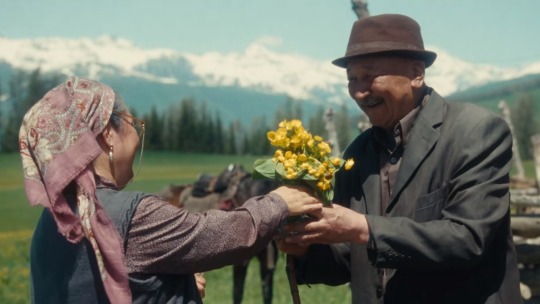


To the Wonder 我的阿勒泰 (2024)
#Cdrama#Still#Central Asia#Kazakh#Steppe#Chinese Drama#中文#China#Xinjiang#Chinese#中国#Orta Asya#Nomadic
331 notes
·
View notes
Text

Clothes study 🖋️🪷
#chinese culture#chinese animation#tang dynasty#chinese hanfu#hanfu#chinese art#digital painting#digital art#art#artist on tumblr#artists on tumblr#china#art study#concept art#illustration#sketch#chinese drama
73 notes
·
View notes
Text
BUCKLE UP ALL YOU BITCHES!
THE GODDESSS IS BACK!


#liziqi#desi tumblr#ancient china#chinese poetry#chinese fashion#chinese hanfu#chinese drama#sg chinese#chinese actress#chinese paintings#youtube#mandarin#chinese#chinese youtuber#李子柒#chinese culture#culture#china#Cantonese#south asian#asian#being desi#desi dark academia#desi girl#desi#cnliziqi#i lost my shit#im so fucking happy#she is back
124 notes
·
View notes
Text
I was promised in marriage to a Chinese prince (like in one of those fantasy dramas in China) and I did not want to marry him.
So I kept jumping down from high places (there was modern hip-hop music in the background for some reason) but every time I jumped down from somewhere, I lost 10 years of my life and did not die immediately, like I wanted.
The prince also kept chasing me around to catch me but he never succeeded.
At the end, I needed to jump one last time to actually die and escape the prince forever. But the moment I jumped, I woke up. I could still remember the background hip-hop music up to 10 minutes after waking up.
I am not Chinese, by the way.
#dream#text#November 7th 2023#marriage#china#drama#chinese drama#fantasy#fantasy drama#music#hip hop#hip hop music#queueueueueueueueueueueueueue
639 notes
·
View notes
Text








a OHSHC cafe officially opened today in South Korea as a collaboration between toon!que, a themed cafe venue, and OHSHC. The cafe will be open during the period of November 22, 2024 to January 5, 2025.
#ouran#ohshc#ouran high school host club#(for archival purposes)#kinda cool how korea is getting ouran events as well#I forgot to post that there was a collab cafe in China too!!!#it was just a rehash of the hakusensha cafe so i didn't post about it#ouran asia renaissance is real#also the last image genuinely made me laugh i had to add it#unrelated note but I am still working on the ouran drama CD translation. about 85% done. will hopefully have it done in a few months :>
103 notes
·
View notes
Note
Faz uma lockscreen da Zhang Miaoyi?
୨୧ zhang miao yi ( atriz ) lockscreens.









#zhang miaoyi#ask#lockscreens#wallpaper#cdrama#cdrama icons#cdrama edit#china girl#chinese#china#chinese actress#chinese drama#chinese actor#dorama icons#doramas#dorama#dorama layouts#cute pictures#girl cute#cute makeup#cute model#cute moodboard#cute girl#cute imagine#cute icons#cute#chinese model#model inspo#model instagram#model icons
76 notes
·
View notes
Text
the scene where lin qiushi is doing Well Math and ruan nanzhu makes a pained face is sooooooo much funnier after the reveal that he's an npc and made of "big data". ruan nanzhu probably could have done the math but he made the CHOICE to hate math.
93 notes
·
View notes
Text
Cnetizens: 'OMG TV shows in the 90's were much better than today''We were so well fed in the past'



#china#fashion#dramas#guzhuang#lmao#funny#that's jiao enjun#I like how he grits a little after he smiles at the other one 'Did you get a good look?'#he is like the ancestor of all guzhuang bl cp lmao#the actor was born in 1967 so that's why cnetizens call him jiaoshu (uncle jiao) for they grew up watching his wuxia dramas#not related but my favourite thing about cdrama is that they never dub the kissing sounds no matter how much kissing the scene has#unlike all hollywood movies or netflix dramas that make that stupid annoying smacking noise#they just have to do the cliche foley sound effect#and why the sound of locking lips is always wet?#Even in the most family-friendly films or sitcoms#they make sure to dub out that kissing sound even for a simple goodbye kiss between a couple in the morning#or a mother kiss her daughter quietly on the crown#it's really disgusting tbh
645 notes
·
View notes
Text



I think he's very good to me. I like him. Don't you find it strange that I like him? The world always felt lonely. Since he appeared he's taken care of me and been good to me. Gradually he became part of my world.
#blue canvas of youthful days#chinese bl#china bl#bl drama#bl series#asianlgbtqdramas#asian lgbtq dramas#tan yin x lao liu#bcoyd#what a good hug though#路过我年少时光的蓝色
108 notes
·
View notes
Note
Do you have a favourite c-drama, either historical, modern or fantasy? I really enjoyed watching Everlasting Longing
I absolutely have a favourite, along with 3 other that come really close 😃 These 4 shows I've watched for almost 30 years now and I still keep re-watching them because of how amazing they are.
a) 1994 Romance of the Three Kingdoms (三国演义) b) 1986 Journey to the West (西游记) c) 1987 Dream of the Red Chamber (红楼梦) d) 1998 Water Margins (水浒传)
These 4 series were based off of the classical novels of the same names. They were produced by CCTV, the central broadcasting network in China, so we call them 央视版 (central broadcast version) because there are many other adaptations.

Romance of the Three Kingdoms, out of these 4 series this one is my ABSOLUTE favourite. Not only for Chinese drama, this is my favourite show historical, modern, Chinese, English, the top spot in my heart.
This story is set in the Three Kingdoms period of Chinese history. Out of all 4 classics, this one is the most historical, but the story DOES contain many fictional aspects. Many people say it's 70/30 (70% based on history, 30% made up/tweaked from history). The characters themselves ARE all real in history, and the general direction of the story follows history as well.
Near the end of the Han Dynasty, local warlords started gaining power, eventually splitting the country into 3 Kingdoms. That's pretty much the basis of the story. It goes into strategies used in warfare, psychology of using strategies, famous battles, etc. People also use it to discuss some philosophical questions like, honor, right vs wrong (kill an innocent person to calm an entire army, is that justified? etc.), what is acceptable as a leader, being faithful to your country, not giving up, etc.
I've watched this series no less than 20 times over the past 30 years and every time I still laugh and cry. I also know enough about the background when they were filming to know how difficult it was. The series is 84 eps long, they filmed in 5 groups for 3 years (so basically all 5 groups were filming at the same time to save time), even utilizing the military for some of the larger battles. Main character roles were paid 250 yuan/episode (about $34 USD today), which was fairly good for salary back then but nowhere near the outrageous amounts actors get today compared to average worker. The first few months before filming all actors went through training, horseback riding, fighting, going over the novel with experts, learning etiquette and mannerisms, etc.
This series also has my favourite historical figures, Emperor Liubei and his Prime Minister Zhuge Liang. After researching the actual history of this period, these two are my top historical Emperor/advisor pair. An Emperor who trusted his Prime Minister with his Kingdom, and a Prime Minister who fought to the last breath to fulfill the dream they had together T___T 为什么我的鱼水君臣要 BE...😭😭😭
If you're interested in watching this series, @hanchaozhilang is doing English subs for the whole series
Putting up 2 MVs for them here (combined into 1 video), 我家昭烈帝和武侯有排面!!
Srcs: 一知半解书 【悬溺一响,诸葛亮登场】 https://www.bilibili.com/video/BV1nP411W7tA/
博文儿吖 【刘备|正史燃向】翻译翻译什么叫昭烈! https://www.bilibili.com/video/BV14r4y1m7rs/

Journey to the West is based off of a true event in history, during the Tang Dynasty. A monk went on a journey from Chang'an (now Xi'an) to India for Buddhist scriptures. I'm not too familiar with the actual history, but I can imagine back then it would've been an incredibly difficult journey to make.
The novel took that journey and expanded it. They wrote in 3 disciples for the monk (technically 4...the horse who's the son of one of the Dragon Kings is also one), and put 81 "tests" along the way. The monk and his disciples had to overcome these attempts to thwart their journey to finally reach their goal.
The main character of this series isn't actually the monk but his eldest disciple, the Monkey King (top right). The Monkey King (named Sun Wukong) was birthed from a rock, and learned skills like how to transform into various objects, how to fly, etc. At one point he trashed the Jade Emperor (Emperor of the Heavens) palace and was sentenced by Buddha to be trapped under a mountain, but was tasked to assist the monk on his journey 500 years later.
When they filmed this series they were desperately short on funding, only had 1 video camera to use xD Every single main actor took on several roles (some of the smaller monster roles, once all the makeup was on you couldn't tell anyway). The actor who played the Monkey King, Liu Xiao Ling Tong, he came from a family of Peking Opera performers who specialized in the Monkey King role, so he excelled in it.

The novel Dream of the Red Chamber is originally called Story of the Stone (石头记). It centres around several large, rich, powerful families interconnected through marriage, with members serving in the court and one of the daughters even being a concubine to the Emperor. Although the story doesn't specify a dynasty, most people speculate it's likely set in Ming (the author was from the Qing Dynasty).
There are numerous storylines throughout the story, but the main one is between a young man, Baoyu, and his cousin, Daiyu (top left). This novel is incredibly complicated, with an entire profession dedicated to studying just this book (called "Redology" 红学). It can be viewed as telling the rise and fall of a family, but can also be viewed to describe a society and the rise and fall of dynasties. There are many, many characters in this book all with different story arcs. When I was a child, watching this show was just pretty clothes and hair, but as I grew, every time I re-watched the show I found reflections of life in this story. Family relationships, friendships, colleagues, bosses, this story touches on all of them, so whatever age you read this book/watch this show there's things to think about.
Many of the actors for this show were not actors by profession, literally plucked from the crowd. For two years prior to filming, all of them lived together, learning the script, reading the novel, going over it with experts, learning mannerisms, how to write calligraphy, poetry, etc. Their roles weren't immediately set, so during those two years they all tried out different roles, memorized lines, basically like living in a giant dormitory together, so once filming did start their "acting" was very natural.

Water Margins is set in the Song Dynasty. This story, to me, is darker than the other 3. The story depicts a court that is very corrupt and unjust, which forces a lot of otherwise good people to resort to criminal activity. Over 100 of them gather on a mountain in the middle of a lake, called Liangshan, where they essentially become a gang.
The traditional view of them tended to be kind of like Robinhood, raiding local cities and distributing the wealth to the people but if you actually read the book it's darker. Before joining the group, some of them would kidnap women and **** them, or one person had a restaurant where she murdered customers and made them into meat buns O.O;; So...yeah, dark stuff.
But anyway, the story goes into how this group take on the courts, lots of fighting, lots of bloodshed, the ending's really tragic T_T
#中国#china#chinese history#c-dramas#dream of the red chamber#journey to the west#romance of the three kingdoms#water margins#电视剧#古装电视剧#三国演义#西游记#红楼梦#水浒传#央视#央三#86西游#87红楼#98水浒#怀念老剧#前几天看到丞相在B站拜年开心哈哈
103 notes
·
View notes